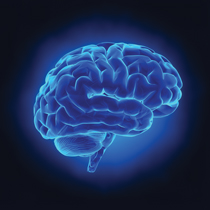feature
Exploring the Brain
by Andrea Appleton
Human beings have been trying to figure out their brains for a long time—and have made more than a few mistaken assumptions along the way. Aristotle believed intelligence resided in the heart, while 19th century practitioners of a “science” called phrenology held that the skull’s contours revealed the personality traits of the brain inside it.
We’ve learned a great deal since then. Yet we still struggle to understand both the physiological brain and the thinking mind. With some 100 billion neurons and 100 trillion neural connections, the human brain is staggeringly complex, and its dense and intricate wiring has yet to be mapped in its entirety.
At Case Western Reserve University, more than two dozen research teams are pursuing a broad range of projects to expand our knowledge. They are improving our understanding of the functions associated with the so-called “normal” brain; developing treatments for people suffering from debilitating physical diseases, mental illnesses, disorders and injuries; and dramatically advancing imaging techniques to provide unprecedented levels of detail about the structures and activities within the roughly 3-pound organ.
In one project, psychology researchers are exploring the different brain functions and structures involved when children solve math problems or read a sentence.
In another, dubbed BrainGate2, researchers aim to use two technologies in tandem—one that records brain activities and another that uses electrical stimulation—to allow people with severe paralysis to move their arms or legs just by thinking about a desired action, such as lifting a mug or brushing teeth.
And in a third, scientists are recording neural activity in the brains of active mice to study how memories are encoded.
In fact, many of neuroscience’s biggest accomplishments involve lessons learned from non-human species. Even fruit flies.
“Most of what we know about how brain circuits function comes from a variety of animal models,” says Lynn Landmesser, PhD, chair of the Department of Neurosciences and the Arline J. & Curtis F. Garvin Professor.
“There are now exciting opportunities to apply the knowledge and tools developed there toward understanding human brain function.”
To accelerate our knowledge of the human brain, the Obama Administration has embarked on a decade-long effort, the BRAIN Initiative (Brain Research through Advancing Innovative Neurotechnologies). The project’s scope has been compared to initiatives like Project Apollo, which put man on the moon, and the Human Genome Project, which identified the complete genetic blueprint for a human being.
But it will take much longer than 10 years to comprehend fully what lies within our own skulls.
The stories that follow provide a small sampling of the extensive amount of brain-related research on campus.
In Fearless, alumna Lisa Beth Allen (WRC ’83) describes life after her brain injury. As she puts it: “I had no idea how much information my brain auto-processed in the imperceptible nanoseconds that made up life—until it didn’t.”
Learn more:
About Lynn Landmesser, Arline J. & Curtis F. Garvin Professor
Read More
Exploring the Brain
-
Cultivating Creativity
Brain scans show power of compassionate coaching.
-
Looking Within
New imaging techniques could spur better treatments.
-
Going Deep in the Brain
Locating best place to deliver electrical stimulation.
-
Restorative Touch
Giving man with prosthetic hand the ability to feel what's in his grasp.
-
Fearless
Alumna Lisa Beth Allen (WRC '83) shares what life is like after traumatic brain injury.
-
Cultivating Creativity
Brain scans show power of compassionate coaching.
-
Looking Within
New imaging techniques could spur better treatments.
-
Going Deep in the Brain
Locating best place to deliver electrical stimulation.
-
Restorative Touch
Giving man with prosthetic hand the ability to feel what's in his grasp.
-
Fearless
Alumna Lisa Beth Allen (WRC '83) shares what life is like after traumatic brain injury.






